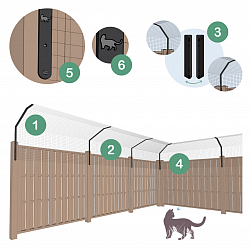Considering Cat Ownership?
Thinking of getting a cat?
Getting Ready for Cat Ownership
Before bringing a cat into your life, it’s important to get your home ready, gather all the essentials, think about the long-term commitment, and do some research to find the perfect cat that fits your lifestyle. This way, both you and your new furry friend will have a smooth start together.
Check If You’re Ready
1. Look at Your Lifestyle:
- Think about your daily routine and how much time you can realistically spend with a cat. Cats are pretty independent, but they still need daily meals, playtime, and attention. If you travel a lot, you’ll want to plan for a pet sitter.
2. Budget for Costs:
- Owning a cat comes with expenses. Upfront costs include adoption fees, spaying or neutering, vaccinations, and supplies. Then there are ongoing costs like food, litter, toys, and vet visits. Don’t forget to prepare for surprises like emergency vet bills by considering pet insurance or setting aside some savings.
3. Choose Between a Kitten or an Adult Cat:
- Kittens are full of energy and need lots of socialising, training, and supervision.
- Adult cats usually have set personalities, tend to be calmer, and often need less hands-on care than kittens.
Make Your Home Cat-Friendly
Your home should be safe and fun for your new cat.
1. Remove Hazards:
- Put away anything that could be dangerous, like:
- Toxic plants such as lilies, philodendrons, and daffodils.
- Loose strings, ribbons, and rubber bands that can cause serious health problems if swallowed.
- Medications and cleaning products—keep these locked away in high cupboards.
2. Secure Risky Spots:
- Tape down or cover electrical cords.
- Use childproof locks on cabinets.
- Keep washing machines, dryers, and toilet lids closed.
- Store fragile or valuable items out of reach.
3. Create Safe Zones:
- Cats love having a quiet, private spot to relax, especially when they’re new. Set up a separate room with their bed, litter box, and food.
4. Offer Vertical Spaces:
- Cats enjoy climbing and watching from high places. Consider a tall cat tree or clear a sturdy shelf for them to perch on.
Gather the Essentials
1. Food and Water:
- Get food and water bowls made of stainless steel or ceramic to avoid chin acne. A food puzzle or water fountain can also keep your cat mentally engaged.
2. Litter and Cleanup:
- Litter Box and Litter: Choose a large, open-top litter box. It’s best to have one box per cat plus one extra, placed in quiet, separate spots.
- Cleaning Supplies: You’ll need a scoop and a good stain and odour remover.
3. Scratching and Play:
- Scratching Posts: Provide a tall, sturdy post or pad to help your cat scratch naturally and save your furniture.
- Toys: Have a mix of toys, including interactive wand toys and ones for solo play.
4. Grooming:
- A brush or comb is key for regular grooming, especially for long-haired cats. You might also want nail clippers and dental care products.
5. Travel:
- A secure cat carrier is a must for trips to the vet or any travel.
Getting Through the First Few Weeks
1. Plan Introductions:
- If you have other pets, look up how to introduce them gradually and safely to your new cat.
2. Schedule a Vet Visit:
- Before or shortly after bringing your cat home, book a checkup. The vet will check for parasites, update vaccinations, and make sure your cat is healthy.
3. Help Your Cat Settle In:
- Your cat might feel stressed or shy at first. Give them space and time to adjust without forcing interaction. Playing with interactive toys can help build trust.
4. Stick to Their Routine:
- Find out what food and litter your cat is used to and keep using those at first to help them feel comfortable.
The "3-3-3 Rule" for Cat Adjustment and Acclimation
The "3 cat rule" most likely refers to the 3-3-3 rule concerning a new cat's adjustment period, rather than a specific guideline for Bengal cats. This rule indicates that it generally takes approximately 3 days to decompress, 3 weeks to adapt to routines, and 3 months to feel fully at home in a new environment. Due to the wild heritage of Bengal cats, they are more prone to stress from changes, making patience essential when acclimating them to a new home.
Understanding the 3-3-3 Rule for Bengal Cats
- 3 Days to Decompress: A new cat may hide, exhibit fear, and show reluctance to eat or drink. It is important to provide a quiet, secure space and allow the cat to approach you at its own pace.
- 3 Weeks to Adjust: The cat will begin exploring its new surroundings and learning the household routine. Establishing consistent feeding and playtimes will help the cat feel comfortable and secure.
- 3 Months to Feel at Home: By this stage, the cat should feel safe, have developed a genuine bond with you, and display its full personality.
Tips for Bengal Cats and the 3-3-3 Rule
- Patience is Key: Bengal cats are sensitive to change and territorial; therefore, patience is crucial. They may not behave typically during the initial months.
- Create a Safe Space: Designate a "kitty room" or quiet area equipped with a comfortable bed, food, water, and a litter box where your new cat can retreat and feel secure.
- Routine is Crucial: Maintaining a predictable daily schedule with set meal and playtimes helps your cat feel safe and reassured.
- Scent Swapping: Before introductions, exchange bedding or toys between your new cat and existing pets to familiarise them with each other’s scent.
- Gradual Introductions: After the cat has settled in the safe room, slowly introduce it to the rest of the home and other pets, carefully monitoring for any signs of stress or conflict.
Financial Considerations of Cat Ownership
The Cost of Cat Ownership
Are you considering welcoming a feline companion into your home this year? Before finalising your adoption, it is essential to understand the financial commitments involved in cat ownership.
We have categorised the expenses into three segments: initial costs upon bringing your cat home, recurring annual essentials, and optional expenditures that depend on your cat’s breed, age, and lifestyle.
Initial expenses for new cat owners typically range from £440 to £1,440 to adequately prepare your home and care for your new pet. Annual essential costs, including food, toys, and litter, range from £530 to £2,025. Additionally, optional expenses typically range from £760 to £1,580 per year for most cat owners.
The Cost of Cat Ownership: Initial Expenses
Welcoming a new cat involves several initial costs that may come as a surprise.
We aim to clarify the budget requirements. Beyond food and litter, your cat will need various supplies and services. Expect upfront costs between £440 and £1,440 during the first year.
First-Time Cat Costs
Item | From | To
Adoption fees | £90 | £115
Spay or neuter surgery | £120 | £180
Microchip | £35 | £35
Initial vet exam and vaccinations | £90 | £135
Collar | £5 | £10
Bed | £10 | £125
Food | £20 | £65
Food and water bowls | £5 | £125
Litter box | £5 | £125
Litter | £20 | £65
Carrier | £15 | £145
Scratching post | £5 | £250
Brush | £10 | £20
Nail trimmers | £5 | £15
Toys | £5 | £30
Total | £440 | £1,440
Let us examine these costs in detail.
Adoption Fees
Adoption fees generally range from £90 to £115. If your cat has not yet been spayed or neutered, these procedures typically cost between £120 and £180.
Health and Wellness
Essential one-time expenses include microchipping, averaging £35, to ensure your cat’s safety if lost, and vaccinations, which usually cost between £90 and £135, including the veterinary consultation.
Cat Supplies
To create a comfortable environment for your new cat, consider the following items:
cat carrier (£15–£145), kitten collar (£5–£10), cat food (£20–£65), water bowls (£5–£125), litter box (£5–£125), litter (£20–£65), scratching post (£5–£250), bed (£10–£125), toys (£5–£30), brushes (£10–£20), nail trimmers (£5–£15).
Do not be deterred by the upper range of these prices. The market offers a variety of options, from basic to premium, including automated feeders and natural litters. Selecting more economical products does not compromise the quality of care and affection you provide.
The Cost of Cat Ownership: Annual Essentials
Cost of Owning a Cat Per Year
Item | From | To
Food | £215 | £805
Litter | £245 | £790
Toys | £35 | £380
Annual check-up | £35 | £50
Total | £530 | £2,025
Once your cat is settled, it is important to budget for recurring annual expenses, which typically range from £530 to £2,025.
The variation in costs is influenced by several factors:
Food: Most cat owners spend between £215 and £805 annually, depending on the type and brand of food (dry versus wet) and the cat’s dietary needs.
Litter: Essential for maintaining hygiene, litter costs generally range from £245 to £790 per year. Some cats are particular about the brand used.
Toys: While cats tend to be less destructive than dogs, providing stimulating toys is vital for their well-being. Annual toy expenses vary from £35 to £380, depending on replacement frequency and quantity.
Routine Veterinary Visits: These typically cost between £35 and £50 annually.
The Cost of Cat Ownership: Optional Expenses
Additional Cat Expenses
Item | From | To
Emergency vet bills | £150 | £310
Dental cleaning | £220 | £420
Wellness vet bills | £90 | £160
Drop-in visits | £15 | £105
Grooming | £65 | £205
Pet insurance | £180 | £325
Litter Genie | £40 | £55
Total | £760 | £1,580
Although not every cat owner will incur these costs, it is prudent to anticipate potential unexpected expenses, which average between £760 and £1,580 annually.
Consider the following possible expenditures:
Emergency Veterinary Visits: While hopefully rare, emergency visits can cost between £150 and £310.
Dental Care: Professional teeth cleaning, though optional, may range from £220 to £420.
Pet Insurance: Many owners choose insurance to mitigate large veterinary bills, with annual premiums between £180 and £325.
Cat-Sitting Services: Depending on your schedule, pet sitting may cost £15 to £105 per night.
Grooming: For long-haired or high-maintenance breeds, grooming appointments typically range from £65 to £205.
Litter Disposal Systems: Devices such as the Litter Genie, which facilitate litter disposal, cost approximately £40 to £55.
End-of-Life Care Costs
Item | From | To
Euthanasia | £225 | £510
Cremation | £100 | £135
Special Foods | £50 | £150
Medical Costs | £85 | £850
Total | £460 | £1,645
Although difficult to contemplate, it is important to plan financially for your cat’s end-of-life care. Costs can vary significantly depending on individual circumstances and preferences. We provide these estimates to assist you in preparing for this challenging period, with total expenses ranging from £460 to £1,645.
Effective Strategies for Introducing Cats to One Another
Thinking of Getting Another Cat?
Here’s How to Introduce Cats the Right Way
Introducing a new cat to your current feline friend can be exciting — but also tricky. Cats are territorial and sensitive to change, so a careful, gradual introduction is key to a peaceful household. Here’s a step-by-step guide:
1. Prepare a Safe Space
Before bringing the new cat home, set up a separate room with:
- Food and water bowls
- A litter tray
- A cosy bed or hiding spots
- Toys and a scratching post
This helps the newcomer feel secure and gives both cats time to adjust to each other’s scents from a distance.
2. Exchange Scents First
After a few days, swap bedding or gently rub a cloth on one cat and place it near the other. This scent-swapping lets them get familiar without direct contact. You can also alternate their spaces for short periods.
3. Controlled Visual Introduction
When both cats seem relaxed with each other’s scent, allow them to see each other through a baby gate or a slightly open door. Observe their reactions:
- Calm curiosity and slow blinking are great signs.
- Hissing or puffed tails mean they need more time.
Never force them to meet too soon.
4. Supervised Meetings
Once they seem comfortable seeing each other, start short, supervised face-to-face sessions. Keep the sessions positive:
- Have treats ready for good behaviour.
- Play with both cats to create positive associations.
Increase the time together gradually each day.
5. Watch for Signs of Stress
Look out for:
- Growling, hissing, swatting
- Hiding or refusing to eat
If tension rises, separate them and go back a step. Patience always pays off.
6. Gradual Integration
When they can interact calmly during several sessions, let them share space freely — with multiple food and litter areas. Continue rewarding calm behaviour.
7. Maintain Harmony
- Keep routines consistent.
- Give equal affection and attention.
- Provide plenty of vertical spaces and toys to prevent competition.
Final Tip
Introductions can take a few days to a few weeks — every cat is different. With patience, space, and positive reinforcement, your cats can become the best of friends (or at least peaceful roommates).











